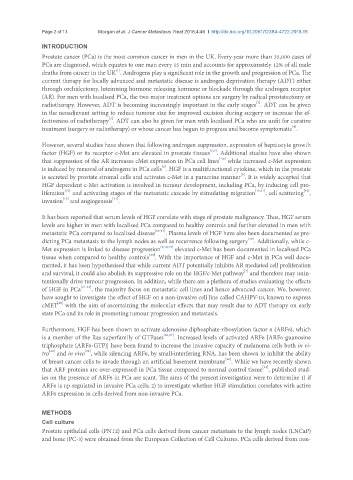Page 546 - Read Online
P. 546
Page 2 of 13 Morgan et al. J Cancer Metastasis Treat 2018;4:46 I http://dx.doi.org/10.20517/2394-4722.2018.19
INTRODUCTION
Prostate cancer (PCa) is the most common cancer in men in the UK. Every year more than 35,000 cases of
PCa are diagnosed, which equates to one man every 15 min and accounts for approximately 12% of all male
[1]
deaths from cancer in the UK . Androgens play a significant role in the growth and progression of PCa. The
current therapy for locally advanced and metastatic disease is androgen deprivation therapy (ADT) either
through orchidectomy, luteinising hormone releasing hormone or blockade through the androgen receptor
(AR). For men with localised PCa, the two major treatment options are surgery by radical prostatectomy or
[2]
radiotherapy. However, ADT is becoming increasingly important in the early stages . ADT can be given
in the neoadjuvant setting to reduce tumour size for improved excision during surgery or increase the ef-
[3]
fectiveness of radiotherapy . ADT can also be given for men with localised PCa who are unfit for curative
[4]
treatment (surgery or radiotherapy) or whose cancer has begun to progress and become symptomatic .
However, several studies have shown that following androgen suppression, expression of hepatocyte growth
[5,6]
factor (HGF) or its receptor c-Met are elevated in prostate tissues . Additional studies have also shown
[7,8]
that suppression of the AR increases cMet expression in PCa cell lines while increased c-Met expression
[8]
is induced by removal of androgens in PCa cells . HGF is a multifunctional cytokine, which in the prostate
[9]
is secreted by prostate stromal cells and activates c-Met in a paracrine manner . It is widely accepted that
HGF dependent c-Met activation is involved in tumour development, including PCa, by inducing cell pro-
[10]
[12]
liferation and activating stages of the metastatic cascade by stimulating migration [10,11] , cell scattering ,
[14]
[13]
invasion and angiogenesis .
It has been reported that serum levels of HGF correlate with stage of prostate malignancy. Thus, HGF serum
levels are higher in men with localised PCa compared to healthy controls and further elevated in men with
metastatic PCa compared to localised disease [15-17] . Plasma levels of HGF have also been documented as pre-
[15]
dicting PCa metastasis to the lymph nodes as well as recurrence following surgery . Additionally, while c-
Met expression is linked to disease progression [5,18,19] elevated c-Met has been documented in localised PCa
[20]
tissue when compared to healthy controls . With the importance of HGF and c-Met in PCa well docu-
mented, it has been hypothesised that while current ADT potentially inhibits AR mediated cell proliferation
[7]
and survival, it could also abolish its suppressive role on the HGF/c-Met pathway and therefore may unin-
tentionally drive tumour progression. In addition, while there are a plethora of studies evaluating the effects
of HGF in PCa [21-24] , the majority focus on metastatic cell lines and hence advanced cancer. We, however,
have sought to investigate the effect of HGF on a non-invasive cell line called CAHPV-10, known to express
[25]
cMET with the aim of ascertaining the molecular effects that may result due to ADT therapy on early
state PCa and its role in promoting tumour progression and metastasis.
Furthermore, HGF has been shown to activate adenosine diphosphate-ribosylation factor 6 (ARF6), which
is a member of the Ras superfamily of GTPases [26,27] . Increased levels of activated ARF6 [ARF6-guanosine
triphosphate (ARF6-GTP)] have been found to increase the invasive capacity of melanoma cells both in vi-
[29]
[28]
tro and in vivo , while silencing ARF6, by small-interfering RNA, has been shown to inhibit the ability
[30]
of breast cancer cells to invade through an artificial basement membrane . While we have recently shown
[31]
that ARF proteins are over-expressed in PCa tissue compared to normal control tissue , published stud-
ies on the presence of ARF6 in PCa are scant. The aims of the present investigation were to determine 1) if
ARF6 is up-regulated in invasive PCa cells; 2) to investigate whether HGF stimulation correlates with active
ARF6 expression in cells derived from non-invasive PCa.
METHODS
Cell culture
Prostate epithelial cells (PNT2) and PCa cells derived from cancer metastasis to the lymph nodes (LNCaP)
and bone (PC-3) were obtained from the European Collection of Cell Cultures. PCa cells derived from non-

